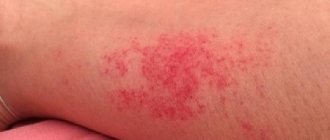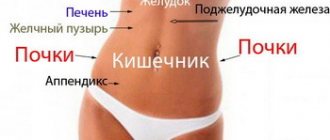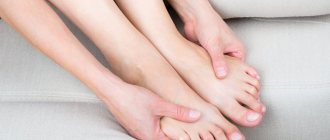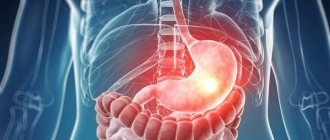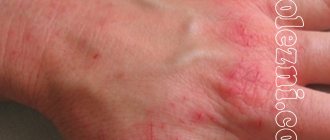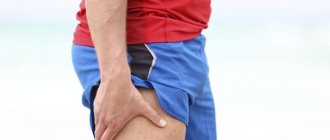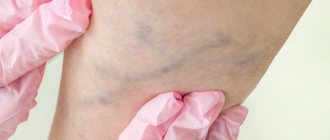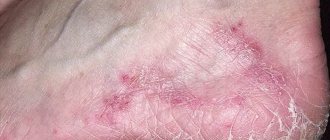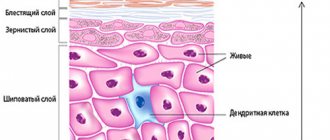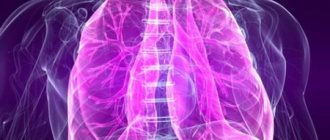Author: Vereskun E. A. Expert: Trubnikov V. I.
Syndromes of lumbago disease 5189
Various unpleasant symptoms that are felt in the lower extremities may indicate that pathological changes are occurring in the tissues of the spinal column. Therefore, when they appear, it is advisable to consult a vertebrologist or orthopedist. You can also visit a neurologist.
Burning pain in the leg is often a consequence of impaired innervation, damage to joint tissue, and changes in hemodynamic processes. When diagnosing, the doctor pays attention to the localization of unpleasant sensations, their intensity and connection with other clinical signs. Burning pain in the left leg may be a result of pinched sciatic nerve due to piriformis syndrome. A burning pain in the right leg may also occur; in both cases, it is possible that the radicular nerves at the level of the lumbosacral spine may be affected.
Pain in the leg as a symptom
A symptom such as aches and pains is synonymous with a certain type of pain. It can be pulling, aching, exhausting or sharp. There is a throbbing pain that subsides for a while, and then appears again. However, the feeling of aching has a more dull expression and can persist for quite a long time.
It’s impossible to immediately say why your legs hurt. For example, aches and pain in the right or left leg may indicate problems with the veins, and sharp and severe pain may result from diseases of the spine.
Causes of aching legs
Aching syndrome is very universal; it can accompany almost any disease of the legs, so only a doctor can identify the variants of the pathology after diagnosis. A common cold, a viral infection of the flu, or a joint reaction to the weather can cause nagging pain in the legs. Some women also complain of body aches during menstruation.
However, you should know that there are a number of dangerous diseases that can cause such manifestations.
Possible dangerous causes of pain and aches in the legs:
- Diseases of blood vessels, veins and arteries.
- Diseases of peripheral nerves.
- Diseases and pathologies of the spine.
- Muscle pathologies.
- Disturbances in joint functions.
- Bone tissue pathologies, leg bone injuries.
- Foot deformity (flat feet).
Arthritis of the hip joint
Osteoporosis causes pain in the lower extremities
Formation of tophi in gout
Flat feet
In addition to diseases, the legs can hurt from long runs in ordinary non-sports shoes, intense loads, and a long static position of a person in one position.
Vascular causes
The most common cause of aches and pain in the legs is vascular diseases:
- thrombosis and varicose veins of the lower extremities, accompanying these diagnoses will be heaviness, swelling of the legs and aches, rapid fatigue, while the pain aches, and frequent cramps of the calf muscles at night;
- thrombophlebitis, in which the legs constantly hurt and pulsate, as if they were burning inside;
- obliterating atherosclerosis, in this case the pain is less disturbing at rest, and movements cause pain in the calves and thighs.
Spinal diseases
Often diseases of the spinal column provoke pain. Pathologies such as lumbar osteochondrosis and intervertebral hernia cause sharp shooting pains in the legs and femoral region.
When the sciatic nerve is pinched, numbness occurs in the legs, stabbing pains radiating to other parts of the body. Experts call this condition sciatica.
Nervous system diseases
The most common nerve disorder associated with aching limbs is peripheral neuropathy. The nerve is damaged due to serious kidney pathologies, lack of vitamins, alcohol abuse or metabolic disorders due to diabetes. The patient complains of pain when lying down, general weakness of the body, and numbness in his legs.
Signs of a pinched sciatic nerve
Aching in the joints of the legs
Joint diseases leading to aching and nagging pain in the legs:
- gout is also accompanied by aching pain that intensifies at night, the affected area pulsates and turns red;
- arthrosis and arthritis of the knee, hip or ankle joints;
- so-called erysipelas, or erysipelas.
Types of arthrosis of joints
Aches in the leg muscles
Most often, muscle pathologies cause aches and other pain symptoms:
- fibromyalgia manifests itself as debilitating pain in the leg muscles at certain points located symmetrically;
- inflammatory processes in the leg muscles or myositis;
- myoenthesitis develops in people of certain professions with excessive muscle overload.
Muscle pain after exercise
Painful manifestations of muscle diseases occur in the thighs and “slide” down, and cramps occur.
Aching in the bones of the legs
Aching bones can also occur due to tumor processes in bone tissue. At the same time, it is accompanied by weakness, fever, and constant pain at night. A network of veins appears at the site of the tumor. Over time, aches and pain may intensify and are difficult to relieve with medications. Also, when malignant tumors appear in the legs, lameness may occur.
Causes of aches and pains during pregnancy
In position, a woman’s body experiences increased stress.
The legs suffer along with the internal organs:
- the diet is incorrect, the lack of microelements in the body of a pregnant woman leads to metabolic disorders;
- fluid retention in a woman’s cells can lead to local cramps in the legs and arms;
- Pathological processes in the veins and arteries of the legs often first appear during pregnancy, while the woman feels heaviness in the limbs more often in the evening, aches, pains and convulsive muscle contractions in the calves.
When to see a doctor
Call an ambulance immediately if:
- The pain prevents you from walking or putting weight on your leg.
- An open fracture or deep cut is obvious.
- You observe several symptoms at once - pain, swelling, redness, a sharp increase in temperature in the limb.
- Before you felt the pain, you heard a loud click, like something popping out in your leg, or a grinding sound.
See your doctor as soon as possible if:
- Signs of infection are observed: the area of skin on the leg turns red and becomes hot to the touch, all this is accompanied by an increase in body temperature as a whole.
- The leg is swollen, the skin is pale and/or feels very cold.
- Swelling is observed in both legs and is accompanied by some breathing problems.
- Your shins hurt a lot after sitting for a long time. For example, after a long trip on a bus or air flight.
- You observe any painful symptoms that develop in your legs without any obvious cause.
Schedule a visit to your physician or surgeon soon if:
- You regularly experience pain during or after walking.
- You are plagued by swelling of the lower extremities.
- The pain, which was initially almost unnoticeable, seems to increase over several days in a row.
- You have noticed swollen veins on your leg, the touch of which causes discomfort.
If you don’t have any of the listed symptoms, you can exhale: most likely, nothing bad is happening to your legs. Of course, this does not mean that you can ignore discomfort. But the chances are high that you can figure out the reasons on your own. Let's get started.
Diagnosis of diseases
Without a proper examination, it is almost impossible to identify the real cause of aches or pains.
To make a diagnosis, specialists prescribe an examination and examine the patient:
- recording information about the location of pain symptoms and their nature, as well as other symptoms;
- performing ultrasound of the extremities;
- X-ray examination;
- magnetic resonance imaging to track the pathology of blood vessels, joints and bones;
- computed tomography.
Blood and urine tests also help clarify the picture of the disease, especially for inflammatory joint diseases associated with rheumatoid factor.
First aid at home
To normalize blood flow in the legs, relieve tension and unpleasant symptoms at home, experts recommend:
- Lie down comfortably and raise your legs to a position slightly above body level and remove all tight clothing and shoes.
- Take a painkiller tablet (Ibuprofen, Pentalgin or Naproxen).
- Perform a gentle massage of the leg muscles in the pain area.
- Take a contrast shower using alternately cool and warm water, rub the sore leg with a terry towel.
- Brew any herbal tea with a relaxing and sedative effect.
How to treat aching legs?
Before starting radical treatment, you must definitely undergo diagnostics at a clinic or any private clinic. Self-medication can be dangerous to health.
Drug treatment
For diseases of the nerves and muscles, several groups of medications are used:
- medications - metabolites that enhance the conduction of nerve impulses, effective agents Actovegin, Instenon;
- drugs affecting blood flow in case of damage to the nerves of the lower extremities - Pentoxifylline, Vazonit, Trental;
- painkillers, NSAIDs and analgesics - Diclofenac, Naproxen, Nimesulide;
- vitamin products in the form of injections and tablets - Milgamma, Kombilipen, CompligamV, Vitaxon;
- ointments and gels for toning veins to relieve signs of varicose pathologies, temporarily help relieve pain, swelling and convulsive contractions of the leg muscles.
Diclofenac
Naproxen
Actovegin for injection
Pentoxifylline - an analogue of Trental
Trental
Nimesulide tablets
To treat diseases of the joints, spine and bone tissue, non-steroidal painkillers, chondroprotectors and corticosteroid hormonal agents are also used.
Physiotherapy and massage
There are many options for effective procedures in the arsenal of modern medicine:
- Application of the UHF procedure. It is a good way to cure vein diseases and endarteritis. The influence of high-frequency currents on inflammation, blood vessels, and blood circulation intensity can effectively relieve the symptoms of the underlying disease.
- Darsonval therapy is a traditional method of physiotherapy used for vascular atherosclerosis.
- Laser therapy is a modern technique that helps cope with diseases of the arteries and blood vessels.
- Phonophoresis and electrophoresis with the use of anti-inflammatory ointments and the administration of corticosteroids is used for joint pathologies.
- Paraffin and mud wraps show effectiveness in combating inflammatory lesions of joints and bones, and injuries.
Physiotherapy
Therapeutic massage as a method of physiotherapy is relevant for a huge number of diseases. It is able to solve a variety of problems; for pain in muscles, leg joints, and even bone diseases, massage procedures relieve symptoms, relax and tone at the same time.
Exercises
Patients experiencing heaviness in the limbs need to use the potential of physical therapy. Exercise helps increase blood flow while relieving muscle tension.
A simple complex is recommended:
- Stand on a small elevation near the wall and how to stand on your toes, but not high. Swing back and after 10-15 seconds return to the starting position. Repeat 4-5 times. If you lose your balance, lean on the wall.
- Pick up small hard objects from the floor with your fingers . You can start with large items and then reduce their size.
- Sitting on a comfortable hard surface , place your feet on the heel area and slowly open and close your toes. Do this until you feel slight muscle tension.
Leg exercises
You can also use the recommendations of the author’s techniques and physical exercises for the musculoskeletal system. Exercises according to Bubnovsky or Dikul, performed correctly, will only bring benefit to the patient.
Folk remedies
Treating joint pain and aches effectively with a baking soda compress:
- boil one liter of water and cool;
- Stir a tablespoon of baking soda in water until completely dissolved;
- Soak a towel or cloth in this water and make a compress on the sore leg.
The compress is kept for 20-30 minutes, while the pain may intensify slightly, which will quickly pass.
Treatment with folk remedies for muscle pain in the legs is recommended using the following good chestnut tinctures:
- Pour crushed wild chestnut fruits with vodka or diluted alcohol.
- For approximately 50 grams of chestnut fruits, take half a liter of vodka.
- Keep the infusion for 2-3 weeks in a dark place.
- Take the finished medicine for 14 days, 45 drops per glass of boiled water.
This tincture can also be used as a rub or compress by soaking a cloth in it and wrapping it around your leg for a couple of hours.
For self-treatment of pain in the legs, it is recommended to use a remedy made from wheat bran with milk:
- mix milk with a few tablespoons of wheat bran until a porridge forms;
- Apply the product to the sore leg and let it dry completely;
- You can cover the top with plastic and leave it longer.
Mint leaves and linden blossom are effective when used as foot baths. To do this, mix a couple of handfuls of dried mint and linden blossom and pour in a liter of hot water, bring to a boil and remove from heat. Bring to readiness in a water bath for half an hour. Immerse your foot in this mixture for 15-20 minutes.
Effective folk recipes
How to eliminate pain in my left leg? Therapy can be carried out not only using traditional methods, but also folk ones. You should know that folk remedies will not help cure the disease. In frequent cases, the infusion helps improve overall well-being and eliminate the symptoms of the disease, but in order to get rid of the pathology, it is important to visit a doctor. Some of the most common home remedies include:
- Comfrey tincture. To prepare it, you need to combine the plant (250 g) with a liter of vodka. Mix everything thoroughly and leave to infuse for 2.5 weeks. After this time, filter the mixture and add another 1.5-2 liters of water to it to obtain a total volume of 3 liters. Drink the medicine several times a day before meals. First you need to dilute 1.5 tsp. medicine with a glass of water. The duration of treatment is determined strictly by the doctor, depending on the strength of the symptoms and the individual characteristics of the patient’s body.
- With the help of tansy infusion, you can improve your overall well-being and eliminate pain in your right leg or left – it doesn’t matter. To do this, you need to pour boiling water (1 tbsp) over the dry plant (2 tbsp) and leave for three hours. Then strain and take 1.5 tbsp. l. 2 times a day.
- With the help of aloe, menthol, eucalyptus and camphor, you can eliminate pain. All ingredients can be purchased at the pharmacy. In frequent cases, the oils are combined in equal proportions and rubbed into the affected area with massage movements. The duration of use of oils should be discussed with your doctor.
Before undertaking treatment for pain in the leg muscles, it is important to consult a doctor. Herbal infusions should not be underestimated, as they have powerful medicinal effects.
Aching in the operated leg after prosthetics
After joint replacement surgery, the patient may experience complications. In addition to aches and pains, there is fever and swelling in the operated leg. This most often manifests itself as infectious complications, inflammation, accumulation of fluid inside the joint or displacement of the prosthesis.
If, after prosthetics, aching pain appears in the limb, you should immediately inform your doctor. It is possible that leg pain and swelling appeared simply as a result of the intervention and will decrease after some time.
Joint replacement
What to do if a child’s legs hurt?
Children's age is always the most difficult, since the specific course of diseases in children is different from that in adults.
When a child complains of aches or pain in the legs, before going to the hospital, you can alleviate his condition:
- Give your child a light foot massage. With intensive growth, children's ligaments and muscles are often in a tense state. A relaxing massage will relieve spasm of smooth muscles in the legs, and this can also be done in case of convulsive manifestations.
- If the leg is injured, bruised or there is a more serious injury, it is worth giving the child Ibuprofen or Panadol for pain relief, immobilize the leg and call for help.
- If a child plays sports or gymnastics , and after training complains of aching legs, it is worth reviewing the exercise and rest regime.
- When the diagnosis has not yet been made , you should not use medications without consulting a doctor and do other procedures.
If there are other signs - swelling in the joint, edema and temperature, you do not need to wait until everything goes away, but urgently show it to a specialist.
Massage
To carry out massage procedures, you can invite a specialist to your home or perform it yourself. This method of treating joint and muscle pathologies is used to improve blood circulation in tissues affected by arthritis, arthrosis, and myalgia. They are saturated with nutrients and biologically active substances, which becomes an excellent prevention of their further destruction.
Ankle massage technique.
Massage treatments have a variety of positive effects on the legs:
- normalize muscle tone;
- reduce the intensity of pain and swelling;
- increase the range of motion in the damaged joint;
- accelerate metabolic processes;
- promote the removal of toxic products of tissue breakdown and the activity of pathogenic microorganisms from joints.
If the patient decides to independently stretch his feet, ankles and knees, then it is advisable to consult with a physical therapy doctor. He will tell you how to do a massage correctly and determine the optimal duration of the treatment procedure.
Before the massage, you can take a foot bath with the addition of coarse sea salt, a couple of drops of pine essential oil, and infusions of medicinal herbs. This will relax the muscles and increase the therapeutic effectiveness of the massage.
Prevention
Preventive recommendations from specialists:
- buy high-quality shoes for comfort , try not to wear high-heeled shoes;
- swim, run, bike and walk, walk in the fresh air;
- always warm up before starting the main exercises on your legs , rest your legs more often so as not to provoke pain;
- special sneakers for training in the gym
- It is very useful to walk barefoot without shoes on stones or uneven surfaces.
It is very necessary, especially in older age, to sometimes measure blood sugar and cholesterol levels. Dietary nutrition is also important if a person is prone to obesity. If you have chronic diseases, you need to visit your doctor every six months and get tested.
Varicose veins
When the legs pull mainly in the afternoon or evening, as well as after prolonged static loads, this may indicate the development of varicose veins. This disease occurs almost twice as often in women as in men, and the risk of getting the disease increases significantly with age.
If you suspect varicose veins, experts advise rinsing your legs with water from bottom to top (2-3 times a day) and taking vitamin C to strengthen the vascular wall
In the early stages, the legs may feel tight and heavy, the limbs get tired faster than usual and sometimes swell. Enlarged veins most often occur at or just below the knee.
Treatment
Varicose veins can be treated with conservative methods only in the early stages or in case of clear contraindications to surgery. First of all, it is recommended to bandage your feet or wear compression stockings. An important condition for treatment is the alternation of static loads with rest, during which you need to give your legs an elevated position. Special exercises for leg extension in the knee and ankle joints help to activate venous outflow.
All patients should limit their salt intake, lose excess weight, and avoid exposure to high temperatures and humidity. At night, while sleeping, you should place your feet on an elevated surface, placing a pillow or cushion under them.
Therapy for varicose veins also includes medications - diuretics, phlebotonics and drugs to improve blood microcirculation. An effective method is the use of ointments and gels containing rutin, heparin, D-panthenol and vein-active components.
